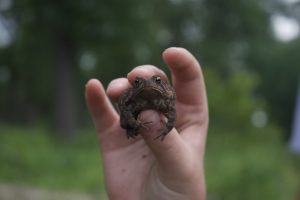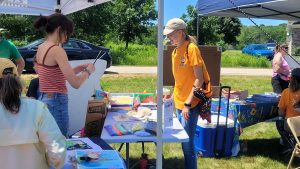
Dunes, a farm, kittens and more! An overview of CLIP Week 4
by Gretchen Casper
 On Monday we went to Glacial Park Conservation Area, and met with Sarah Michehl, TLC’s community engagement specialist. She talked to us about preparing and teaching environmental science to people of all ages. We hiked around Glacial Park and talked about how the glacier helped form McHenry County. We also looked at the both at the Kettle Marsh and the Bog. The Kettle Marsh has a fresh spring feeding into the lake and the bog doesn’t. This creates two very different environments even though they are a few feet away from each other. The bog has a very high pH, and this causes very different range of plants to grow.
On Monday we went to Glacial Park Conservation Area, and met with Sarah Michehl, TLC’s community engagement specialist. She talked to us about preparing and teaching environmental science to people of all ages. We hiked around Glacial Park and talked about how the glacier helped form McHenry County. We also looked at the both at the Kettle Marsh and the Bog. The Kettle Marsh has a fresh spring feeding into the lake and the bog doesn’t. This creates two very different environments even though they are a few feet away from each other. The bog has a very high pH, and this causes very different range of plants to grow.
After lunch we visited Sunfleck Farm, where TLC’s Farm Program Assistant, Claire Hodge, grows vegetables and then sells them through her farmstand or through CSA boxes. We helped her plant pumpkin, squash and then we surrounded the plants with hay to prevent weeds from growing. After that we picked peas, some of which we got to take home.
On Tuesday we prepared the herbicide backpacks with .2% Milestone. Then we had a meeting about the weekend’s Pollinator Safari at Boloria Meadows to plan the event’s details. After that we sprayed herbicide on Bull thistle at Dick Tracey Way Park and Apple Creek in Woodstock. In the afternoon we worked on a Pollinator Safari poster and crafts.
On Wednesday we got a very early start and left for the Indiana Dunes National Park at 6:30 a.m. We met with Laura and Zach there and hiked around Miller Woods. We collected seeds from Lupine flower and porcupine grass. For the porcupine grass we had to cut or snap of the the long extra part of the grass because if left on, the seeds curls around each other and makes a big clump. After that we went to the beach for lunch, and then we visited the fire station and talked with Micah Bell about his job and then he showed us the fire trucks and explained how it worked. We learned that the three main components of a fire were the fuel, spark and oxygen. And to put out a fire you have to take away the oxygen, spark and fuel.

On Thursday we made 5% Roundup herbicide spray and sprayed reed canary grass, sweet clover and vetch at Westwood Conservation Area in Woodstock. We also found a litter of baby kittens that were very cute, but we left them alone so their mother could take care of them. After our work day, we worked on finishing up the final parts of the Pollinator Safari poster.

On Friday we started late at 6:30 p.m., with one-on-one meetings with Kim about the CLIP program and how it was going for us. Next we had a discussion on climate change solutions in Costa Rica, and Andrea Meza’s push for change. After that we drove to Yonder Prairie and met up with TLC Board Member Randy Schietzelt and his wife Nancy to study insects at night. After finding an open spot, we set up an old bed sheet and put lights on a tripod facing the bed sheet, and then we waited until sunset for the bugs to come out. A bunch of bugs and moths came out, got attracted to the light on the bedsheet, were we could look at them. We identified a few moths and bugs and took pictures.
On Sunday, we worked at the Pollinator Safari event, helping kids with a craft to make butterflies, bees and caterpillars, which we really enjoyed.














